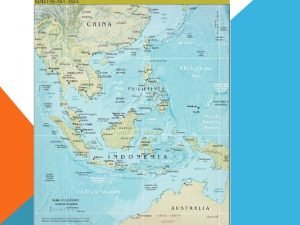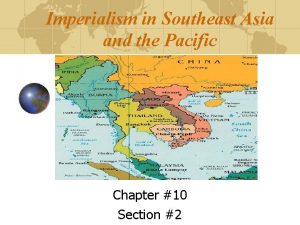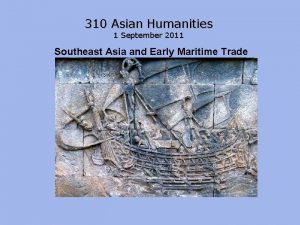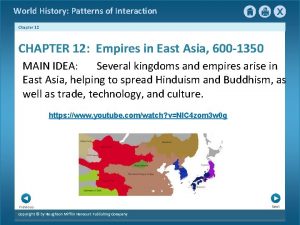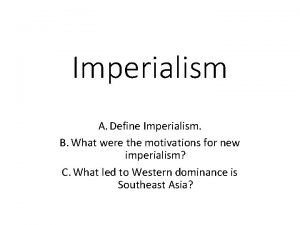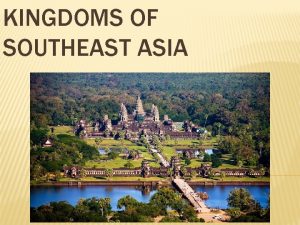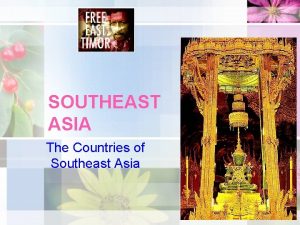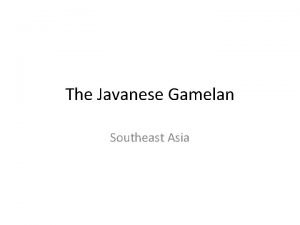SOUTHEAST ASIAS GEOGRAPHY Geography Asia is the worlds









- Slides: 9

SOUTHEAST ASIA’S GEOGRAPHY

Geography: • Asia is the world’s largest continent with a total land area of more than 17 million square miles. • More than 4 billion people live in Southern and Eastern Asia, with over half of that number living in China and India alone. • The continent has a wide variety of physical features, including deserts, peninsulas, and the world’s highest mountains. Ganges River: • The Ganges River starts in the Himalayas and flows southeast through India and Bangladesh for more than 1, 500 miles to the Indian Ocean. • The name comes from a Hindu goddess and the river is considered sacred to the Hindu religion. • It is the most important river to the Indian subcontinent. • The river runs through India’s most fertile farmland densely populated areas. • Because so many people live and work along the Ganges, the water in the river is heavily polluted.

Huang He (Yellow River): • The Huang He, or Yellow River, begins in the mountainous plateau of Tibet and flows east to the Yellow Sea. • This is China’s second-longest river. • Chinese civilization began in the central area of this river basin. • The river is named for the muddy yellow silt that it carries along its path to the Yellow Sea. • The silt creates rich topsoil for farmers; however, annual floods make the river’s path dangerous. • It’s nickname is “China’s Sorrow” because of the frequent flooding. Chang Jiang (Yangtze) River: • The Chang Jiang (Yangtze) River begins in the Tibetan Plateau and travels east until it reaches the East China Sea. • It’s the largest and longest river in China (over 3, 400 miles) and the third-longest in the • world. • The Chang Jiang empties into the Pacific Ocean.

Chang Jiang (Yangtze) River Continued: • The Chang Jiang is extremely important for China because it provides hydroelectric power, water for irrigation, and transportation for cargo ships. • The Chang Jiang and Huang He Rivers are connected by one of the world’s oldest canal systems, the Grand Canal. • Some parts were built over 2, 000 years ago. Bay of Bengal: • The Bay of Bengal is an extension of the Indian Ocean. • The Bay of Bengal touches India on its west and Myanmar on its east. • The Ganges and many other large rivers flow into this bay. Indian Ocean: • The Indian Ocean is the third largest of Earth’s five oceans. • It is located between Africa to the west, Asia to the north, and Australia to the east.

Sea of Japan: • The Sea of Japan is a small sea that is bound by Russia to the north, the Korean Peninsula to the west, and Japan to the east. • It is an arm of the Pacific Ocean that lies between the Asian continent and Japan. • The sea has large deposits of mineral resources and abundant fish, both of which are important to Japan’s economy. South China Sea: • The South China sea is located between Vietnam and the Philippines. • The South China Sea connects the Pacific and Indian oceans, so many of the world’s international shipping channels run through it. • There are often violent monsoons and typhoons in this region. Yellow Sea: • The Yellow Sea is an extension of the Pacific Ocean that lies between China and the Korean Peninsula.

Yellow Sea Continued: • The Huang He (Yellow River) empties into the Yellow Sea. • It becomes the East China Sea south of the Korean Peninsula. • The Yellow Sea is well-known for its fishing industry. • Unfortunately, in recent years, many species of fish have declined in the Yellow Sea due to overfishing by some countries. Gobi Desert: • The Gobi Desert is Asia’s largest desert. • It expands across southern Mongolia and northern China. • Much of the Gobi Desert is covered with sand bare rock that is exposed by powerful winds blowing across the region. • The Gobi Desert is known as “Shamo”, the Chinese word for “sand desert”. • It can be one of the hottest and also one of the coldest places on earth.

Taklimakan Desert: • The Taklimakan Desert lies between two rugged mountain ranges in northwestern China. • It is over 600 miles in length, making it one of the longest deserts in the world. • Giant sand dunes cover 85% of its surface. • The Taklimakan Desert receives very little annual precipitation. • The plant and animal life in this desert have had to adapt to the dry environment in order to survive. Himalayan Mountains: • The Himalayas lie along the northern edge of the Indian subcontinent and the southern border of China. • They form the natural border between India and China. • The mountains stretch for about 200 miles. • The Himalayan mountain range is the world’s highest mountain region. • It is sometimes called “the roof of the world” because of the area’s high altitudes. • Nine of the world’s ten largest peaks are located here.

Korean Peninsula: • The Korean Peninsula is a mountainous peninsula that juts out of northeastern China in between the Yellow Sea and the Sea of Japan. • Over half of the peninsula is made up of mountains, but there is still plenty of rich farmland. • Since the end of World War II in 1948, the peninsula has been divided into two countries: North Korea (communist) and South Korea (democratic).

 Yellow sea and east china sea
Yellow sea and east china sea Lesson 1 physical geography of southeast asia
Lesson 1 physical geography of southeast asia Norton worlds together worlds apart
Norton worlds together worlds apart Southeast asia climate
Southeast asia climate Imperialism in southeast asia and the pacific
Imperialism in southeast asia and the pacific Sea roads as a catalyst for change southeast asia
Sea roads as a catalyst for change southeast asia Empires in southeast asia
Empires in southeast asia Chapter 12 section 5 kingdoms of southeast asia and korea
Chapter 12 section 5 kingdoms of southeast asia and korea Wallace's line
Wallace's line Define imperialism
Define imperialism



